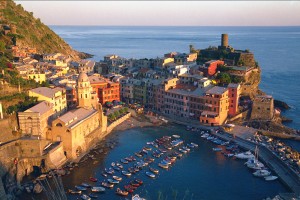 |
|
Enlarge photo |
Just between you and me, 25 years as a tour guide got me burned out on gelato. I remember as a kid swooning over “Italian Ice Cream” in Germany. And then I oversaw two decades of “it’s to die for” gelato appreciation. Now, as I’m rustling through Europe for four months out of five, I rarely succumb to the temptation to eat ice cream. (It’s a key element to my extremely simple weight-loss program over here.) Yesterday, I was just finishing up my visit to Prague Castle, which brags it’s the biggest anywhere. If exhausting is a measure of big, I’ll buy that claim. You go through the castle like a pinball — it’s all downhill, and everyone funnels out the lower gate.
An incredibly charming schoolboy was hawking Prague’s favorite ice cream. It’s called “Cream and Dream,” which almost makes me blush. Anyway, he lured me in for a taste. Banana was his favorite, so I tried it. I purchased a cone. It almost lived up to its name.
Across the way, I had to update the Barbie Doll Museum. It’s one of those museums that sounds silly, yet is actually great — a vast collection of all things Barbie, dating back to 1959, with social commentary. Looking at the buxom first edition, you can understand why these sirens of capitalist discontent that objectified women’s bodies weren’t allowed here until 1989. (I can’t resist a Nicaragua tangent: Like or loathe their economics, one of the great things about the Sandinistas was that they outlawed using women’s bodies as advertising tools.) I had to tour the Barbie Museum fast because they didn’t let in ice cream. I parked my guide at the stairwell, licking hers and protecting mine.
Barbie in the can and ice cream gone, our next stop was just across the castle lane — the Lobkowicz Palace. I’ve been 10 days now in Hungary and the Czech Republic. They both have a passion for charging admission to dreary palaces stripped bare by the communists and today offering little more than new stucco on high vaulted ceilings as a rack upon which to hang boring stories of local nobles from centuries past.
Just an hour earlier, I had hated the Rosenberg Palace, which is now included in the Prague Castle combo-ticket to make up for the fact that the Golden Lane is closed. I have never understood the appeal of the Golden Lane (even though it’s one of the “Thousand Places to See Before You Die”), and hoped this would be a net plus. It wasn’t.
The Lobkowicz Palace is a new addition to our guidebook; it just opened a couple of years ago, and I’d yet to visit it. As it was late and I was running out of steam fast, I was going to wimp out and just check the details at the ticket booth, but a banner outside claimed it was “Prague’s Best Palace to Visit.” Those kinds of claims generally make me want to disprove them — as they are generally misleading come-ons. So I rallied and got a ticket. It included an audioguide narrated by the count of the palace himself, William Lobkowicz. Audioguides like this one — in which noble heirs of palaces actually walk you through their grand halls and introduce you to great-great-grandpapa in musty old family portraits — are often wonderfully quirky and intimate.
The Lobkowicz audioguide was fabulous. I’m into these lately, with the work we’re doing on our own audio tours, and this one was lovingly designed and produced…and Mr. Lobkowicz had a perfect voice for the project. (Being a count has been outlawed now in the Czech Republic, so I need to bring him down to earth — “Mister” rather than “Count.”)
I was happy to be turned on by the Lobkowicz Palace. I appreciate that they include the audioguide in the visit, and that it brings the place to life and lets you get to know the family — which lost all their possession to the Nazis, got them back for three years after World War II, and then lost them all again to the communists. Now they are embracing the challenge of sharing their noble heritage with their country, and it’s a great gift to locals and foreign visitors alike.
Turning in the audioguide and ready to leave, I gave the clerk my card and told her to thank the count. She asked me if I’d like to meet him. Turns out he, his wife Sandra (a Romanian American he met at Boston College while in exile during the Cold War), and their key curator knew my work and were thrilled to be in the book. Like nobility all over 21st-century Europe, they are working hard to make their vast palaces economically viable as cultural attractions, and need the publicity guidebooks provide.
William and Sandra took me through the palace for a more intimate peek at things. We talked about post-Nazi restitution challenges and triumphs, and the fact that many nobles get a bad rap since the French Revolution. (“We’re just real people who own lots of big palaces.”)
Sitting down to coffee with the best view possible of Prague from their noble loggia, we brainstormed ways to get the palace more recognition. Suddenly a cute schoolboy joined the conversation. It was William junior… done selling ice cream for the day.



